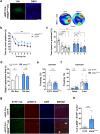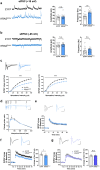Neuron type-specific expression of a mutant KRAS impairs hippocampal-dependent learning and memory
- PMID: 33082413
- PMCID: PMC7575532
- DOI: 10.1038/s41598-020-74610-y
Neuron type-specific expression of a mutant KRAS impairs hippocampal-dependent learning and memory
Abstract
KRAS mutations are associated with rare cases of neurodevelopmental disorders that can cause intellectual disabilities. Previous studies showed that mice expressing a mutant KRAS have impaired the development and function of GABAergic inhibitory neurons, which may contribute to behavioural deficits in the mutant mice. However, the underlying cellular mechanisms and the role of excitatory neurons in these behavioural deficits in adults are not fully understood. Herein, we report that neuron type-specific expression of a constitutively active mutant KRASG12V in either excitatory or inhibitory neurons resulted in spatial memory deficits in adult mice. In inhibitory neurons, KRASG12V induced ERK activation and enhanced GABAergic synaptic transmission. Expressing KRASG12V in inhibitory neurons also impaired long-term potentiation in the hippocampal Shaffer-collateral pathway, which could be rescued by picrotoxin treatment. In contrast, KRASG12V induced ERK activation and neuronal cell death in excitatory neurons, which might have contributed to the severe behavioural deficits. Our results showed that both excitatory and inhibitory neurons are involved in mutant KRAS-associated learning deficits in adults via distinct cellular mechanisms.
Conflict of interest statement
The authors declare no competing interests.
Figures




References
Publication types
MeSH terms
Substances
LinkOut - more resources
Full Text Sources
Molecular Biology Databases
Miscellaneous

